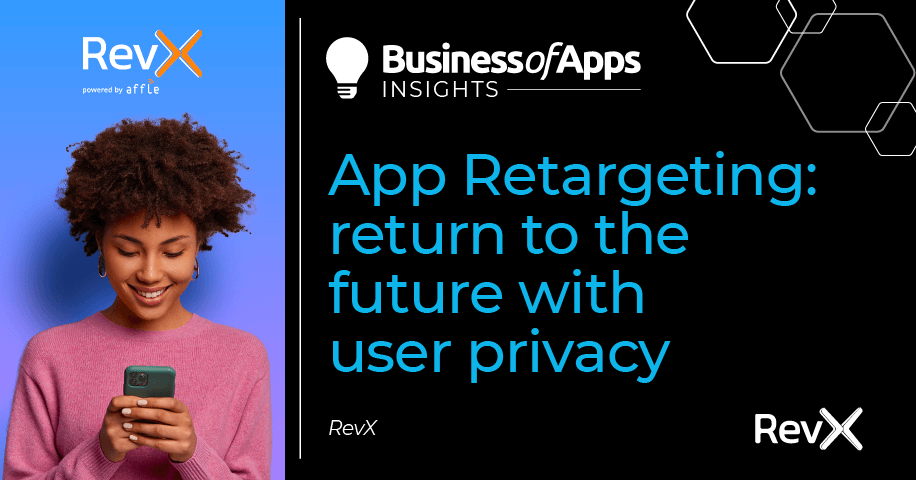Retargeting is the go-to tactic when growing your app. And although privacy changes in iOS rocked the boat, app retargeting continues to be a powerful tool for app marketers running campaigns both on Android and iOS (given the users opt-in to tracking).
Why retargeting?
- It’s more cost-effective to re-engage users than to acquire them. Acquiring new users is five to ten times costlier than retargeting them.
- It prevents user churn by prompting users to come back and reuse the app instead of abandoning it.
- Increases engagement by keeping your daily active users returning more frequently, keeping them interacting and exploring the app.
- Drives more paying users = more revenue: retargeting the most active and high-value users increases the likelihood of conversion and purchase.
When to start retargeting campaigns for your app?
When to start depends on the very nature of your app business. Advertisers should watch for early signs of user inaction in the first days post-install and identify lapsing users before they churn. Starting your retargeting campaigns to target users in their early journey yields the best results.
Retargeting on LAT traffic?
Privacy changes changed retargeting strategies. Within iOS, LAT (Limit Ad Tracking) is a default privacy feature that prevents advertisers from targeting individual users deterministically. LAT traffic is, therefore, non-personalized traffic that can use contextual targeting for brand awareness goals as well as probabilistic attribution.
In scenarios where inventory transits to SKAdNetwork and advertisers no longer have IDFA, app retargeting, as you know it, is not possible. What is very much possible is to run blended programmatic campaigns that offer incremental results independently of the target audience – LAT and non-LAT.
IDFA isn’t dead; it is only not available for a part of app users. Data indicates that opt-in rates are on the rise. On LAT, retargeting investment can be applied to a different campaign strategy focused on brand awareness and UA.
2021 results proved that pausing retargeting budgets facing user privacy changes wasn’t the best approach. Advertisers that continued to invest budgets into retargeting for non-LAT audiences were able to continue gathering valuable data points that guided their decisions on how to adjust campaigns for LAT and unlock further scale.
For LAT, continue to wisely run blended campaigns, test more, and gather insights. As advertisers are running more campaigns in this new environment, it is becoming clearer how to optimize them to reach the desired outcomes.
App Retargeting in Non-LAT is business as usual
For non-LAT traffic on Android and iOS (for users who opt-in and give consent), app retargeting continues to be a winning strategy. It can be measured on the basis of last-click attribution via an MMP integration.
Advertisers starting to build a retargeting plan using programmatic advertising can start with broader strategies, with a broader targeting, and progressively narrow down into segmentation and personalization.
Ultimate App Growth Guide 2025
Boost your app’s success with the Ultimate App Growth Guide! 🚀 Expert insights, proven strategies & must-know tips. Download now!
Master app growthAt RevX, we guide advertisers in this process to match the best approach to their specific goals and needs. The more data and insights gathered in your campaigns, the better our team can make our platform optimize the campaigns further for better performance and connection with users.
Retargeting and audience segmentation
On LAT, individual user data isn’t available anymore, so audience segmentation becomes even more important to define. Advertisers can rely on supply signals, first-party data, and contextual targeting.
Contextual data allows for a certain degree of personalization and enables targeting of similar audiences without requiring an individual user’s ID. RevX supports our clients in analyzing this data for programmatic campaigns. For deterministic attribution on iOS, SKAN is offering some degree of visibility while MMPs continue to provide longer-term data insights through probabilistic matching – which with a >85% match rate during a short-term window delivers nearly deterministic accuracy.
For non-LAT, we continue to use funnel-specific conversion rate analysis to segment audiences that are more likely to drive conversions.
Know your data, build a healthy audience
Data holds the answers needed to plan and optimize retargeting campaigns: data shows the making of your app funnel and how healthy it is. At RevX, we support data analysis to help you identify different audience segments’ performance and potentially “leaky buckets”.
Data analysis is step one. The analysis must be paired with action. Invest in the segments with high engagement uplift potential.
Marketers looking to scale retargeting efficiently in a LAT environment need to focus on three things: first-party data-led audience management, probabilistic measurement techniques, and creative strategy built around high-impact concept development instead of granular iteration. We are constantly improving user engagement through creative optimization.
Longer lifetime value, higher revenue with retargeting
Retargeting campaigns become a no-brainer. You engage your users far beyond the install and compel them to continue interacting with the app. Consequently, users’ lifetime value increases, and so does your revenue.
Retargeting can complement CRM
CRM and paid retargeting don’t cannibalize each other. They can run hand in hand if your teams coordinate efforts.
CRM uses different channels such as email and push that can be highly personalized and are relatively low-cost. The logical thing for your app is to maximize these channels first. App retargeting can act as a supporting and leading channel. Here’s how it can work.
Not all users will allow for communication via CRM channels. Data shows that only less than 50% of users allow emails and notifications. The chunk of users you can’t reach via CRM are not totally inaccessible.
If advertisers map out the user journey and coordinate efforts, they can plan out strategies for both CRM and paid channels where they can first notify users via push users that are not responsive or can’t be reached; they can then be targeted via app retargeting instead. Advertising allows for more scale, more creativity in ad formats, and different contextual environments. The trick to make it all work is to know your user journey in-depth and test combinations of channels to see what works best for your app.
How to choose a retargeting partner?
Choosing a programmatic partner to manage your retargeting campaigns can be easy if you focus on these three factors: their technical capabilities, the expertise and availability of the team to advise you on best approaches and optimizations, and the reporting and analysis capabilities. Will they work as an extension of your internal team to help you hit your goals?
Many marketers initially set out to manage programmatic in-house but quickly learn that a partner with vast industry experience will be more effective. Building in-house capabilities demand a huge investment in technical infrastructure, know-how, and additional human resources. A programmatic provider offers all this at a fraction of the cost and their accumulated experience working with other businesses similar to yours.
A reputable partner should be willing to review your goals and priorities and provide you with strategic recommendations on how they can help your app grow sustainably.
RevX offers this level of service, and its platform runs on advanced algorithms to buy high-quality inventory and get RTB requests at an ideal price. Supply profiles are run through a proprietary DMP to enrich decision-making with data from lookalikes. This allows us to derive information from users that are still available via device IDs, extrapolate your findings into LAT audiences through supply lookalikes, and subsequently test similar conditions on your blended campaigns.
Get a return on your efforts
With the industry changing, app retargeting campaigns need to be adapted, not paused. Find a retargeting partner that can help you pivot your strategy to cater to both LAT and non-LAT campaigns to keep re-engaging your audience in a meaningful way. Keep your focus on metrics like ROAS and uplift measurement to ensure that your budget is always deployed meaningfully.
For iOS, at RevX we are fully integrated with programmatic global inventory suppliers, SKAN, and MMPs for postback processing, mapping, and forwarding. Additionally, we are continuously conducting extensive tests on LAT traffic to ensure that we are ready to drive the highest possible media buying efficiency. Contact us to know more. We’re ready to brave these winds of change with you.












